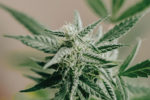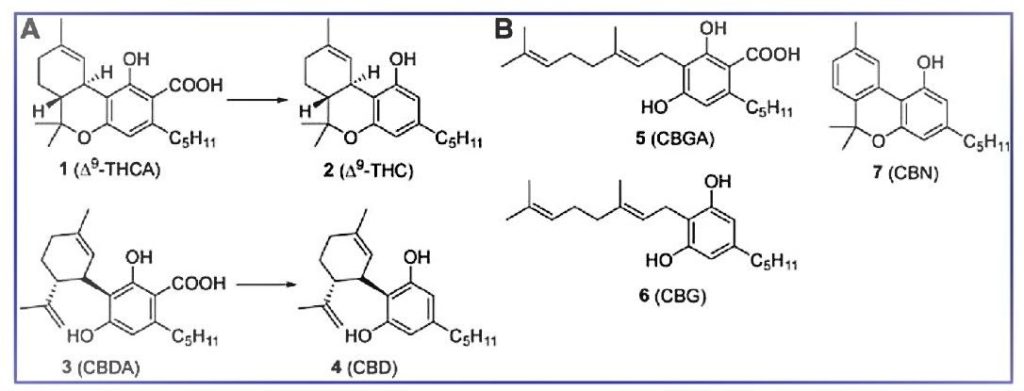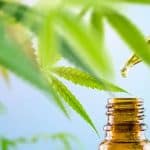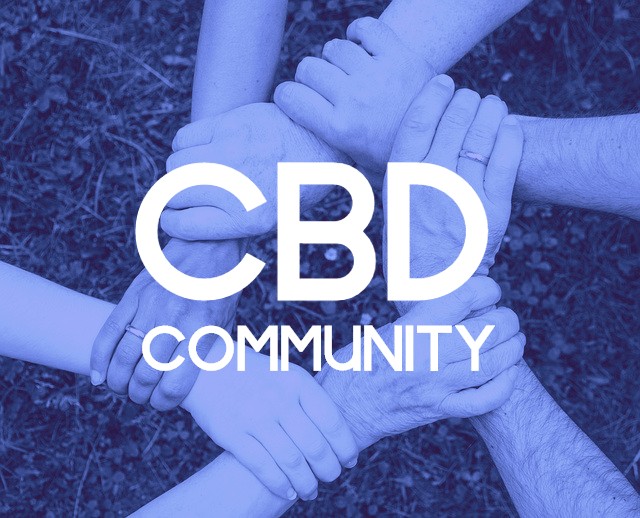Last updated on 22 November 2021
Introduction
THC and THCa originate from the same mother compound CBG but exhibit different properties.
THC or Tetrahydrocannabinol is one of the naturally occurring cannabinoids purified from cannabis plants. And, Tetrahydrocannabinolic acid (THCa) is the acidic precursor of THC.
Since the invention of THC in 1964, it has occupied central focus because of its therapeutic value and psychoactive properties. Misuse of the compound by some sections has left it inaccessible to seekers who might get benefitted from its medicinal properties.
Therefore, better knowledge and improved awareness could go a long way in bringing about a structure to the growing Industry.
This article aims to present the key differences between THC and THCa based on scientific evidence while also understanding the benefits of each of these compounds.
THC Vs THCA- A quick overview
| Property | THC | THCa |
| Cannabinoid | Naturally occurring | Naturally occurring |
| Bio-synthesis | THCa decarboxylase to THC | THCa is a precursor to THC. It is the acid controlling the psychoactivity of cannabis sativa |
| Psychoactivity | Psychoactive | Non-psychoactive |
| Benefits | Therapeutic applications & recreational | Therapeutic applications |
| Availability | THCa has to be decarbed to derive THC | Can be found in freshly harvested plant |
| Molecular structure | C21H30O2 | C22H30O4 |
| Interaction with ECS | Exhibits high affinities and physiological activities. | Exhibit poor potency at CB receptors |
The above table gives a quick glimpse to understand the difference between THC and THCa. There is more to know from scientific references.
Background of THC
To begin with, some references from literature, a 2006 study1 provides a reference that THC was first extracted by Wollner, Matchett, Levine, and Loewe in the year 1942 as a mixture of -Δ8 and Δ-9 THC. Later, in 1964, its isolated form Δ9THC from cannabis was derived and synthesized in Raphael Mechoulam’s laboratory. And their chemical structures were also decoded.
Tetrahydrocannabinol or Δ9 THC is the primary psychoactive component in the cannabis plant known for its neurological and psychological effects.
Even before we get into discussing the morphology of THC, a brief overview of its chemotypes could help simplify our understanding of THC.
- According to a 2011 study2 THC is the most common phytocannabinoid that is produced in the Cannabis drug chemotypes.
- While there have been different approaches to classifying the chemotypes of cannabis, analysis from a 2016 study3 reports that in 1971, cannabis was first characterized into two phenotypes. The third category was identified in 1973.
- THC:CBD ratio > 1, it was a drug type,
- THC:CBD <1 it was a fiber Type
- THC: CBD close to 1 – Intermediate type.
- Followed by the 2018 study4 provides yet another insight. The below table provides a summary of the same.
| Chemotype | Characteristics | Usage |
| I | drug type plants with a predominance of Δ9-THC-type cannabinoids | -Medicinal or recreational purposes, -Most investigated |
| II | plants with intermediate characteristics between drug-type and fiber-type plants | -Textile or food purposes |
| III & IV | fiber-type plants containing high levels of non-psychoactive cannabinoids and very low amounts of psychoactive ones | -Textile or food purposes- Contain cannabinoid acids, cannabidiolic acid (CBDA), cannabigerolic acid (CBGa), followed by their decarboxylated forms: cannabidiol (CBD) and cannabigerol (CBG) |
| V | fiber-type plants containing almost no cannabinoids | -European countries have approved for commercial use. -The Commercial value of hemp and a legal limit of 0.2-0.3% THC is usually applied. |
Where is THC found?
THC is found in the trichomes of the Cannabis plant. These are hair-like structures on the surface, its head resembling a crystal and connected to a stalk. The basic function of trichomes is to provide a self-defense mechanism to the plant.
A 2012 study5 points out as ‘direct defenses’ that are characteristic of the plant biology that acts as mechanical protection on the surface.
For example, hairs, trichomes, thorns, spines, or thick leaves. Even more terpenoids, alkaloids, phenols that either kill or retard insects, or animals.
Furthermore, inferences from the 2012 study6 clarifies that these trichomes contain abundant cannabinoids. The capitate stalked trichomes (large), contain tetrahydrocannabinol acid ( THCA), cannabidiolic acid ( CBDA), cannabigerolic acid ( CBGA) including their decarboxylated derivatives Tetrahydrocannabinol, THC, cannabidiol CBD, and cannabigerol CBG.
Role of THC in the Endocannabinoid system
The endocannabinoids and their receptors are present throughout the body and are involved in the complex actions of all organs. Including, the immune system and nervous system.
Even more, the 2013 study7 asserts that the endocannabinoids are the major physiological activators of CB1 and CB2, yet they are not standard neurotransmitters.
From the 2017 study8 we can understand that the CB1 receptor is the predominant form with abundant G -protein-coupled receptors found in the brain, central nervous system, liver, kidneys.
More importantly, it is this CB1 receptor that binds the main psychoactive ingredient in marijuana that is THC and mimics its effects.
On the other hand, CB2 receptors work more independently and are found in the cells and tissues of the immune system. They exhibit a more defined pattern in the brain.
In a nutshell, according to the 2013 study7 THC, acts on the brain by muscling in on the neuronal signaling system ( the receptors) by mimicking it and hijacking it.
Medical Benefits of THC
- 2011 study9 reports THC’s analgesic, muscle relaxant, and antispasmodic properties. In addition, it is a bronchodilator, neuroprotective antioxidant, and has 20 times the anti-inflammatory power of aspirin.
- In a 2019 study10 THC has been reported to have generated measurable improvements in symptom relief. As well as this study emphasis that Cannabis with THC could be more widely accessible for pharmaceutical use.
- The 2014 survey study11 conducted among 100 patients who used cannabis for one year, reported on some of the therapeutic benefits. They are relief from stress, anxiety, insomnia, improved appetite, relief from depression, and discontinuity from medications for pain.
THC: Overuse or effects
Besides the growing body of knowledge with regard to the scope of therapeutic applications of medical marijuana, it is always good to equally understand the implications of overuse or misuse.
The 2014 study12 points out risks of addiction. Especially, marijuana use by adolescents, in particular, is troublesome. Besides this, Impaired neural connectivity in specific brain regions, Increased risk of anxiety and depression, psychoses for people with pre-existing history are some of the risks attributed to marijuana use.
More importantly, with respect to the risks of motor vehicle accidents, overuse of marijuana poses adverse effects.
On this subject the 2020 study13 reports that THC causes psychomotor impairment and puts the driver at increased risk of motor vehicle collisions. Regular cannabis users tend to show persistent elevation of THC even after a period of abstinence.
What is THCa?
Tetrahydrocannabinolic acid, a non-intoxicating compound, is naturally found in live or freshly harvested cannabis plants. The process of decarboxylation takes place once the plant dries and is exposed to heat. Subsequently, THCa gets converted to THC.
At this point, it is imperative to understand that all the major cannabinoids begin their life as CBGA (cannabigerolic acid). Hence also is referred to as the mother of all cannabinoids. Maturity, exposure to heat, light, or other driving forces ( including burning or vaporizing) initiates thermal decarboxylation.
A 2009 study14 illustrates that THCA is the acidic precursor of THC by non-enzymatic decarboxylation. Additionally, THCa is biosynthesized by THCa synthase from the biosynthetic reaction of CBGa (cannabigerolic acid)
As you can see in the below picture, the evolution of these cannabinoids represented in their chemical structure, The right-hand side (B) of the image shows the conversion of CBGa to CBN to CBG. The left-hand side (A) shows the transformation of THCa and CBDa to THC and CBD, respectively. At every stage, the acidic carboxyl group gets eliminated.
Moreover, the ‘big 6’ cannabinoids THC, CBD, CBG, CBN, CBC, and THCV begin their life in acidic forms. Hence, the CBGa converts into THCa, CBDa, and CBCa.
Where is THCa found?
THCA is readily available in fresh plant material, their leaves could be chewed or juiced. However, this does not give any psychoactive effects.
Medical Benefits of THCa
Cannabinoids research is growing like never before because of its promising qualities in therapeutic applications.
While several studies have begun to focus their attention on the medical benefits of THCA, the available research is anecdotal evidence and patient records. Some of the potential benefits could be:
- Anti-inflammatory
- Neuroprotective properties
- Antiemetic
- Anti-proliferative
- Insomnia
- Pain management
Research on THCa-A
- The 2016 study16 brings forth some of its therapeutic potential benefits supported by Cell-based experiments on THCa-A. They could exert:
(i) immunomodulatory, (ii) anti-inflammatory, (iii) neuroprotective, and (iv) antineoplastic effects
The study also clarifies the unclearness about THCa-A:
1965 – First identification of THCa – Prof.Friedhelm Korte
1969 – Raphael Mecholam reported the existence of a second acid- the isomer of THCa, and named the former THCa-A and the latter THCa-B.
- In addition, the 2017 study17 reports that instability in the clinical application of THCa-A, despite growing interests in its therapeutic use. It adds that THCa-A lacks cannabimimetic effects, on the hypothesis that it has little binding potential with CB1.
- Contrary to the above study, a recent 2019 study18 investigated the possibility of dimerization of THCa-A to solve the issue of decarboxylative instability. This could by-pass the clinical applicability problems and support developments in pharmacological applications.
Conclusion
- Cannabis research, its extracts, and cannabinoids have broadened the scope of pharmacology and clinical applications. It has promoted selective breeding of specific chemotypes and inventions of synthetic versions leading to improvements in the therapeutic index of cannabis.
- Research on THCa and its therapeutic potential is in its infancy stage and could demonstrate positive outcomes.
References
- Pertwee RG. Cannabinoid pharmacology: the first 66 years. Br J Pharmacol. 2006;147 Suppl 1(Suppl 1): S163-S171. doi:10.1038/sj.bjp.0706406 [↩]
- Russo EB. Taming THC: potential cannabis synergy and phytocannabinoid-terpenoid entourage effects. Br J Pharmacol. 2011;163(7):1344-1364. doi:10.1111/j.1476-5381.2011.01238.x [↩]
- Brian F. Thomas, Mahmoud A. ElSohly, Chapter 1 – The Botany of Cannabis sativa L., Editor(s): Brian F. Thomas, Mahmoud A. ElSohly, The Analytical Chemistry of Cannabis, Elsevier,2016, Pages 1-26, ISBN 9780128046463 [↩]
- Federica Pellati, Vittoria Borgonetti, Virginia Brighenti, Marco Biagi, Stefania Benvenuti, Lorenzo Corsi, “Cannabis sativa L. and Nonpsychoactive Cannabinoids: Their Chemistry and Role against Oxidative Stress, Inflammation, and Cancer”, BioMed Research International, vol. 2018, Article ID 1691428, 15 pages, 2018. https://doi.org/10.1155/2018/1691428 [↩]
- War AR, Paulraj MG, Ahmad T, et al. Mechanisms of plant defense against insect herbivores. Plant Signal Behav. 2012;7(10):1306-1320. doi:10.4161/psb.21663 [↩]
- Happyana, Nizar & Agnolet, Sara & Muntendam, Remco & Dam, Annie & Schneider, Bernd & Kayser, Oliver. (2012). Analysis of cannabinoids in laser-microdissected trichomes of medicinal Cannabis sativa using LCMS and cryogenic NMR. Phytochemistry. 87. 10.1016/j.phytochem.2012.11.001 [↩]
- Alger BE. Getting high on the endocannabinoid system. Cerebrum. 2013;2013:14. Published 2013 Nov 1 [↩] [↩]
- Kendall DA, Yudowski GA. Cannabinoid Receptors in the Central Nervous System: Their Signaling and Roles in Disease. Front Cell Neurosci. 2017;10:294. Published 2017 Jan 4. doi:10.3389/fncel.2016.00294 [↩]
- Russo EB. Taming THC: potential cannabis synergy and phytocannabinoid-terpenoid entourage effects. Br J Pharmacol. 2011;163(7):1344-1364. doi:10.1111/j.1476-5381.2011.01238.x [↩]
- University of New Mexico. THC found more important for therapeutic effects in cannabis than originally thought: Researchers measure product characteristics and associated effects with mobile app.” ScienceDaily. ScienceDaily, 26 February 2019 [↩]
- Webb CW, Webb SM. Therapeutic benefits of cannabis: a patient survey. Hawaii J Med Public Health. 2014;73(4):109-111 [↩]
- Volkow ND, Baler RD, Compton WM, Weiss SR. Adverse health effects of marijuana use N Engl J Med. 2014;370(23):2219-2227. doi:10.1056/NEJMra1402309 [↩]
- Yuan Wei Peng, Ediriweera Desapriya, Herbert Chan, Jeffrey R Brubacher,“Residual blood THC levels in frequent cannabis users after over four hours of abstinence: A systematic review.” Drug and Alcohol Dependence, Volume 216, 2020,108177, ISSN 0376-8716 [↩]
- Taura F. Studies on tetrahydrocannabinolic acid synthase that produces the acidic precursor of tetrahydrocannabinol, the pharmacologically active cannabinoid in marijuana. Drug Discov Ther. 2009;3(3):83-87 [↩]
- Lewis-Bakker, Melissa & Yang, Yi & Vyawahare, Rupali & Kotra, Lakshmi. (2019). Extractions of Medical Cannabis Cultivars and the Role of Decarboxylation in Optimal Receptor Responses. Cannabis and Cannabinoid Research. 4. 10.1089/can.2018.0067 [↩]
- Moreno-Sanz, Guillermo. Can You Pass the Acid Test? Critical Review and Novel Therapeutic Perspectives of Δ 9 -Tetrahydrocannabinolic Acid A. Cannabis and Cannabinoid Research. 1. 10.1089/can.2016.0008 [↩]
- McPartland JM, MacDonald C, Young M, Grant PS, Furkert DP, Glass M. Affinity and Efficacy Studies of Tetrahydrocannabinolic Acid A at Cannabinoid Receptor Types One and Two. Cannabis Cannabinoid Res. 2017;2(1):87-95. Published 2017 May 1. doi:10.1089/can.2016.0032 [↩]
- Arben Cuadari, Federica Pollastro, Juan D. Unciti-Broceta, Diego Caprioglio, Alberto Minassi, Annalisa Lopatriello, Eduardo Muñoz, Orazio Taglialatela-Scafati, Giovanni Appendino,The dimerization of Δ9-tetrahydrocannabinolic acid A (THCA-A),Acta Pharmaceutica Sinica B,Volume 9, Issue 5,2019,Pages 1078-1083,ISSN 2211-3835 [↩]
Author
With close to two decades of successful stint in the Media industry, I felt I was surely missing a piece in my life puzzle. I took a break and set out to seek the purpose of my life. I travelled, lived out of a suitcase, let things flow into life without resisting, and after five challenging years, I found my rhythm. I love to write about Cannabis and Health and try my best to simplify esoteric concepts into simple ideas for life.








